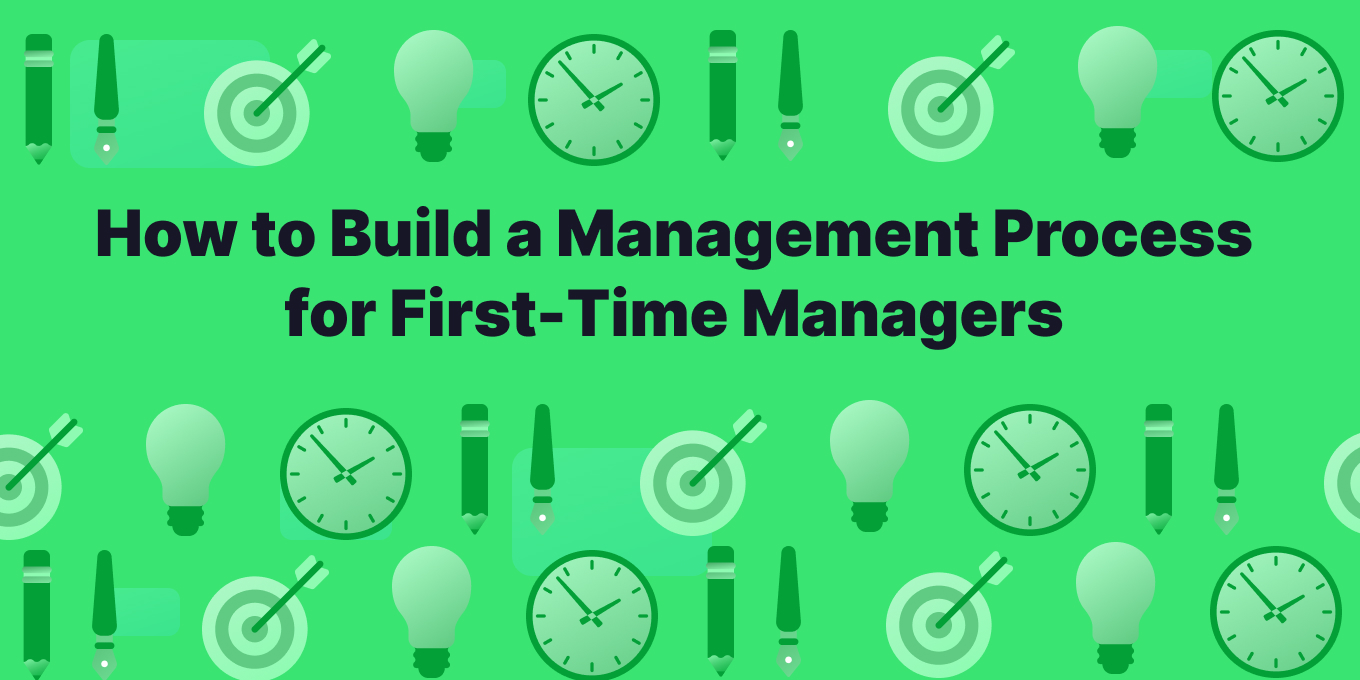Congratulations — you’re a manager now. After working your way up the career ladder, you get to run a team, groom your colleagues into managers, and set yourself up for even more success.
However, with all the excitement that comes from becoming a manager, there’s just as much anxiety.
Managing a team or a project is daunting, especially if you’re a first-time manager.
What Is a Management Process?
A management process is a series of steps for planning, organizing, and leading projects. It’s best to document your management process in an internal knowledge base so you can reference it whenever you start working on a new project.
It also makes it easier for other managers and colleagues to follow your process when you’re sick or on vacation. Effective process management involves strategic planning and organizing business operations to align with organizational goals.
For example, for the head of a customer service team, their management process could look something like this:
- Plan — Set customer satisfaction and response time goals.
- Organize — Assign specific customer inquiries and support tasks to team members.
- Lead — Provide the team with necessary training, tools, and resources to resolve customer issues efficiently.
This approach ensures effective task management and enhances overall customer service performance.

Why Do You Need a Management Process?
A management process provides a repeatable set of steps that you can rely on to execute your work. These processes ensure that you can complete tasks in a consistent manner, making it easier to streamline your current operations and tackle new, challenging projects.
Using project management software can greatly assist in managing multiple processes and workflows effectively.
Management processes also give your employees more autonomy, which is a basic psychological need and the leading contributor to happiness.
On the flip side, defaulting to procedures and policies that dictate the way your employees can or can’t do their work plummets innovation and employee engagement.
Use the following steps to create and implement a management process for your current and upcoming projects.

Get more info about processes & documentation from Tettra
- 15 best online documentation tools
- What is process mapping?
- The top process documentation tools
- Why you need project documentation
- How to build effective product documentation
- How to document your processes
- The types of business process documentation you need
- How good team documentation boosts productivity
How Do You Build a Management Process?
Planning
In the first stage of the management process, your job is to set challenging yet attainable goals and choose the optimal strategy to achieve them.
This strategic management process involves determining why and how you’ll achieve a goal, not just the goal itself.
1. Determine why and how you’ll achieve a goal, not just the goal itself.
Too often in business, we conflate the measurement of a goal with the goal itself. This can incentivize you to focus too much on the results instead of the thing that produces the results — the process.
To open up this common bottleneck, make sure you determine why you want to accomplish your goals and how you’re going to accomplish them — not just what you’re going to accomplish. For instance, in our objectives and key results (OKR) template, we recommend setting objectives, which are inspirational goals rather than numeric ones.
2. Brainstorm (the right way).
The typical brainstorming session might seem like the most collaborative and effective way to generate creative ideas, but according to psychologists, it’s actually one of the worst.
To avoid falling victim to stifling cognitive biases, consider asking all your team members to brainstorm ideas on their own and privately submit them to you — they’ll think of a larger amount of better ideas.
3. Chop up your project into small yet challenging tasks.
When you slice your project into chunks, you give your team more opportunities to feel accomplished at work.
For example, when Wistia decided to focus on growing as much as possible, they set ambitious goals to meet their revenue target. However, these goals were overly ambitious and encouraged short-term thinking, plummeted their workforce’s creativity, and killed their motivation.
Organizing
In the next stage of the management process, define each role on your team and delegate responsibilities accordingly. Effective process management involves defining roles and responsibilities clearly to boost your team’s efficiency and effectiveness.
When defining every role on your team, each member will know exactly what their job is. This will help them stay in their lane and work with each other — not against each other. To designate the amount of decision-making power each role on your team has, consider using the DACI framework.
Leading
During the final stage of the management process, you’ll steer your team toward the finish line. Here are three management best practices to help you do so.
1. Make sure your team has a purpose and meaningful work to do.
According to renowned author and motivational speaker Simon Sinek, the most primal part of your brain, the limbic system, is in charge of all your emotions and decision-making. That’s why emotions drive action. To motivate your team to do their best work possible, be sure to emphasize the deeper meaning behind their jobs.
2. Focus on the process, not the results.
Ironically, homing in on the process, rather than the results, is how teams produce better results. Your process is your team’s differentiator. In fact, psychologists even suggest that people who are intrinsically motivated produce higher quality work than people who are extrinsically motivated.
3. Foster psychological safety.
If you develop a work culture where your colleagues aren’t afraid to fail, you’re tapping into their primal desire to feel safe. This creates trust and loyalty towards you as their leader and motivates them to work harder for you. People who feel more psychologically safe also tend to generate more creative ideas.
Building Your First Management Process
Being a first-time manager is like being a first-time anything. You might feel like you have no idea what you’re doing. You might even feel like a complete impostor at times. But don’t fret. Armed with this guide to building a management process, you can develop one that will help you lead a team that consistently delivers high-quality work, regardless of the project at hand.
In conclusion, effective process management, including project management, change management, strategic management, and business process management, is crucial for organizational success.
Utilizing project management software and understanding the project management process can help manage change and improve performance. Managing change effectively through a structured change management process can also lead to better employee performance and alignment with business goals.
Use Tettra To Document Your Management Processes
Tettra is a top choice for HR documentation due to its comprehensive features and ease of use.
- User-friendly interface: Simplifies navigation and document management.
- Efficient organization: Allows for easy categorization and retrieval of documents.
- Collaboration tools: Enables team members to update and share information seamlessly.
- Integrations: Works well with Slack, Google Drive, and other popular tools.
These features ensure that HR documentation is always current, accurate, and easily accessible, fostering effective knowledge management within the organization.


